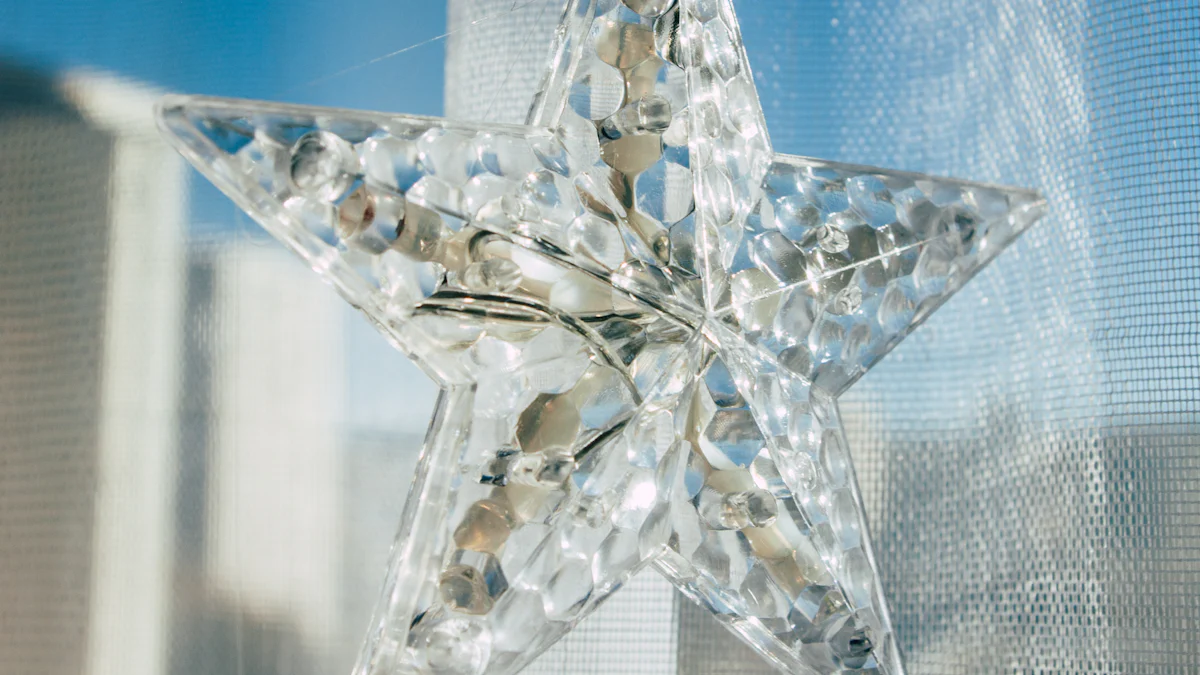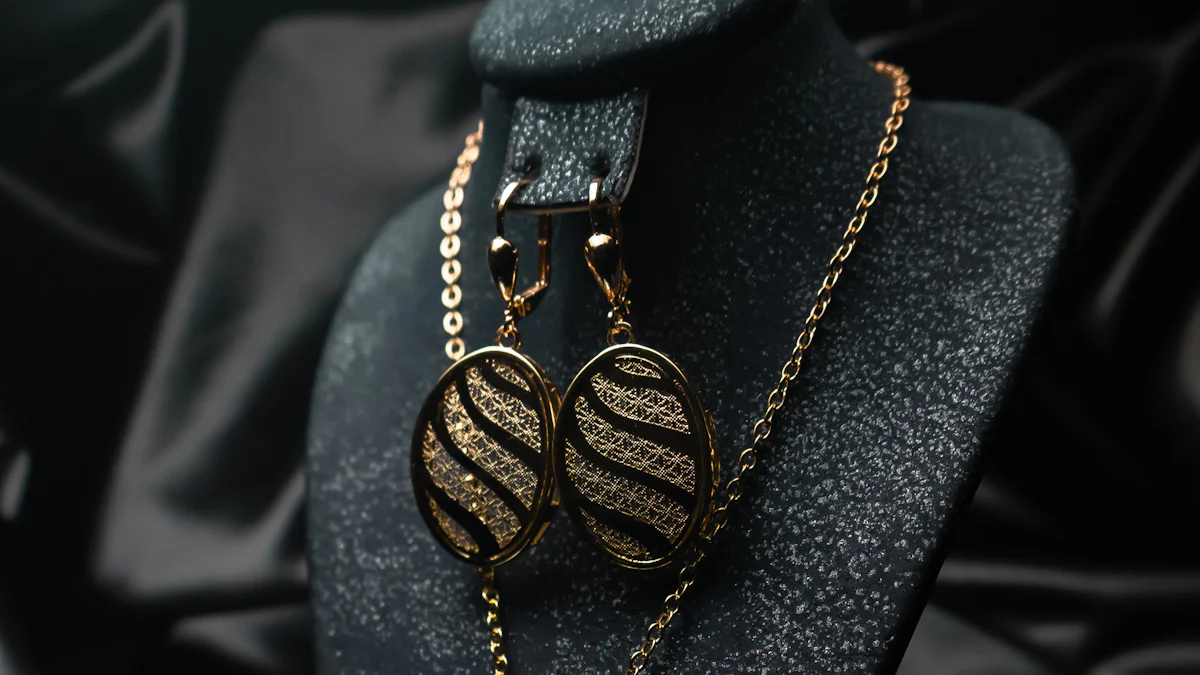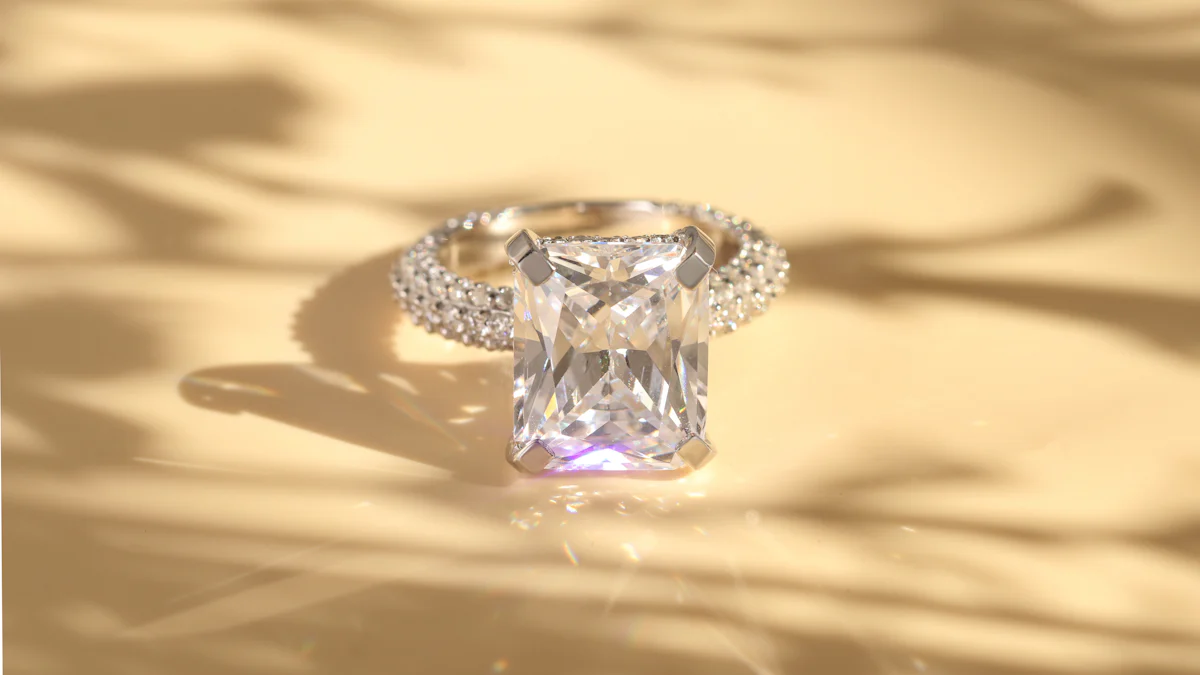VVS Clarity Diamond: VVS1 vs VVS2 Comparison

When you explore the world of diamonds, understanding the differences between VVS1 and VVS2 diamonds becomes essential. Both belong to the Very Very Slightly Included category, yet they differ in VVS clarity diamond. VVS1 diamonds boast higher clarity with inclusions so minute that even under 10x magnification, they remain elusive. In contrast, VVS2 diamonds may have slightly more visible inclusions, though still invisible to the naked eye. This subtle difference impacts their value, with VVS1 diamonds typically commanding a higher price due to their superior clarity.
Key Takeaways
- VVS1 diamonds offer superior clarity with fewer inclusions, making them a premium choice for those seeking the best in diamond quality.
- VVS2 diamonds, while slightly lower in clarity, provide excellent value and are a more budget-friendly option without sacrificing beauty.
- Both VVS1 and VVS2 diamonds appear flawless to the naked eye, making them ideal for those who prioritize visual purity.
- When choosing between VVS1 and VVS2, consider your budget and personal preferences to find the perfect diamond for your needs.
- Investing in VVS1 diamonds can be worthwhile due to their rarity and higher resale value, while VVS2 diamonds offer great quality at a lower price.
- Understanding the placement and size of inclusions can help you appreciate the subtle differences in sparkle and brilliance between VVS1 and VVS2 diamonds.
- Request certification from a reputable gemological laboratory to ensure the clarity grade of your chosen diamond.
Understanding VVS Clarity Diamond
What is Diamond Clarity?
When you look at a diamond, its clarity plays a crucial role in determining its beauty and value. Clarity refers to the presence of internal or external characteristics, known as inclusions and blemishes, respectively. These imperfections can affect how light passes through the diamond, impacting its brilliance and sparkle. In the world of diamonds, clarity is one of the "Four Cs" used to evaluate quality, alongside cut, color, and carat weight.
The Gemological Institute of America (GIA) developed a clarity grading scale that ranges from Flawless (FL) to Included (I). VVS clarity diamonds, which stand for Very Very Slightly Included, sit near the top of this scale. They have such minute inclusions that even under 10x magnification, they are challenging to detect. This high level of clarity ensures that VVS diamonds exhibit exceptional light performance, making them highly desirable.
Importance of Clarity in Diamonds
Clarity significantly influences a diamond's appearance and value. High-clarity diamonds like VVS1 and VVS2 are prized for their superior light performance and stunning sparkle. Their radiant appearance truly captivates the eye, making these diamonds stand out. When you choose a VVS clarity diamond, you invest in a gem that offers dazzling brilliance and an appealing look.
The importance of clarity extends beyond aesthetics. It also affects the diamond's durability. Fewer inclusions mean fewer weak points, which can enhance the stone's longevity. For those who seek a diamond that combines beauty with lasting value, VVS clarity diamonds present an excellent choice.
Defining VVS1 and VVS2
When you delve into the world of diamonds, understanding the nuances between VVS1 and VVS2 diamonds becomes crucial. Both belong to the Very Very Slightly Included category, yet they possess distinct characteristics that set them apart.
Characteristics of VVS1 Diamonds
VVS1 diamonds represent the pinnacle of clarity within the VVS category. These diamonds feature inclusions so minute that even under 10x magnification, they remain nearly invisible. A skilled diamond grader might struggle to detect these tiny imperfections, which speaks volumes about their exceptional clarity.
- Minimal Inclusions: The inclusions in VVS1 diamonds are extremely hard to see, even with a loupe.
- High Clarity Grade: As the highest clarity grade in the VVS category, VVS1 diamonds offer unparalleled brilliance and sparkle.
- Value and Rarity: Due to their superior clarity, VVS1 diamonds often command a higher price, making them a prized choice for those seeking the best in diamond clarity.
Characteristics of VVS2 Diamonds
VVS2 diamonds, while slightly lower in clarity than VVS1, still maintain an impressive level of quality. These diamonds are eye-clean, meaning that to the naked eye, they appear flawless.
- Slightly More Inclusions: Compared to VVS1, VVS2 diamonds have relatively more inclusions, but these are still not visible without magnification.
- Balanced Choice: VVS2 diamonds offer a balance between high clarity and cost, making them a popular choice for those who want quality without the premium price tag.
- Market Availability: VVS2 diamonds are more common in the market, providing a wider range of options for buyers.
Both VVS1 and VVS2 diamonds fall under the umbrella of vvs clarity diamond, showcasing minimal inclusions that enhance their beauty and value. When choosing between them, consider your personal preferences and budget to find the perfect diamond for your needs.
Visual Differences in VVS Clarity Diamond

Can You See the Difference?
When you examine VVS clarity diamonds, you might wonder if you can spot the differences between VVS1 and VVS2 with the naked eye. The truth is, both types of diamonds exhibit such high clarity that their inclusions are nearly invisible without magnification. Gemologists often note that VVS1 diamonds have inclusions located towards the edge of the stone. This positioning makes them less noticeable compared to VVS2 diamonds, where inclusions might be more centrally positioned or slightly larger.
"VVS1 diamonds typically have inclusions located towards the edge of the stone, making them less visible than those in VVS2 diamonds," says a gemologist.
In practical terms, this means that while both VVS1 and VVS2 diamonds appear flawless to the unaided eye, VVS1 diamonds offer a marginally higher level of clarity. This subtle distinction can be significant for those who prioritize the utmost purity in their diamond selection.
Impact on Diamond Appearance
The placement and size of inclusions in VVS clarity diamonds can subtly influence their overall appearance. VVS1 diamonds, with their edge-positioned inclusions, tend to reflect light more uniformly. This results in a brilliant sparkle that captivates the viewer. On the other hand, VVS2 diamonds, though still stunning, may have inclusions that slightly affect light reflection due to their central location.
- Uniform Light Reflection: VVS1 diamonds often reflect light more evenly, enhancing their brilliance.
- Slight Variation in Sparkle: VVS2 diamonds might exhibit a minor variation in sparkle due to the position of their inclusions.
Ultimately, both VVS1 and VVS2 diamonds maintain exceptional beauty and allure. When choosing between them, consider how much you value the minute differences in clarity and appearance. Your personal preference will guide you to the perfect vvs clarity diamond that meets your aesthetic desires.
Pricing Comparison of VVS Clarity Diamond

When you consider purchasing a diamond, understanding the pricing differences between VVS1 and VVS2 diamonds becomes crucial. Both types offer exceptional clarity, but their prices vary due to subtle differences in their characteristics.
Cost of VVS1 Diamonds
VVS1 diamonds represent the pinnacle of clarity within the VVS category. Their superior clarity and rarity often result in a higher price tag. You will find that:
- Premium Pricing: VVS1 diamonds typically command a premium price due to their minimal inclusions and exceptional brilliance.
- Investment Value: The rarity of VVS1 diamonds makes them a valuable investment for those seeking the best in diamond clarity.
Cost of VVS2 Diamonds
VVS2 diamonds, while slightly lower in clarity than VVS1, offer a more budget-friendly option. They maintain high quality and appeal without the premium cost. You can expect:
- Affordable Option: VVS2 diamonds are much more affordable than VVS1 diamonds, making them an attractive choice for budget-conscious buyers.
- Value for Money: Despite being less expensive, VVS2 diamonds still provide excellent clarity and beauty, offering great value for your investment.
Factors Influencing Price Differences
Several factors contribute to the price differences between VVS1 and VVS2 diamonds. Understanding these can help you make an informed decision:
- Clarity Grade: The primary factor influencing price is the clarity grade. VVS1 diamonds have fewer and less noticeable inclusions, which increases their value.
- Market Demand: The demand for higher clarity diamonds like VVS1 can drive up prices, while VVS2 diamonds remain more accessible.
- Rarity: The rarity of VVS1 diamonds contributes to their higher cost, as they are less common than VVS2 diamonds.
When choosing between VVS1 and VVS2 diamonds, consider your budget and personal preferences. Both types of vvs clarity diamond offer exceptional beauty and value, allowing you to find the perfect gem that meets your needs.
Buying Considerations for VVS Clarity Diamond
When you decide to purchase a VVS clarity diamond, several factors come into play. These considerations help ensure that you select a diamond that aligns with your personal taste, budget, and intended use.
Personal Preferences
Your personal preferences play a significant role in choosing the right diamond. VVS clarity diamonds are popular for their exceptional clarity and brilliance. They are often referred to as "eye clean" because they appear flawless to the naked eye. If you value a diamond's visual purity and want a stone that sparkles brilliantly, a VVS clarity diamond might be the perfect choice for you. Consider the shape and size that appeal to you, as these aspects will also influence the overall appearance of the diamond.
Budget Considerations
Budget is a crucial factor when purchasing a diamond. VVS1 diamonds, with their superior clarity, typically come with a higher price tag compared to VVS2 diamonds. If you have a flexible budget and prioritize clarity, investing in a VVS1 diamond could be worthwhile. However, if you seek a balance between quality and cost, VVS2 diamonds offer excellent clarity at a more affordable price. They provide great value without compromising on beauty, making them an attractive option for budget-conscious buyers.
Intended Use and Investment Value
Consider how you plan to use the diamond. If you're purchasing it for an engagement ring, a VVS clarity diamond ensures a stunning centerpiece that will captivate attention. For those interested in investment, VVS1 diamonds hold significant value due to their rarity and high clarity grade. They can serve as a valuable asset over time. On the other hand, if the diamond is for everyday wear, a VVS2 diamond offers durability and beauty without the premium cost.
Ultimately, your decision should reflect your personal style, financial situation, and the purpose of the diamond. By weighing these considerations, you can confidently choose a VVS clarity diamond that meets your needs and enhances your collection.
When choosing between VVS1 and VVS2 diamonds, you should consider the benefits of each clarity grade.
-
VVS1 Diamonds: These diamonds offer superior clarity with fewer inclusions, visible only under 10x magnification. Their rarity and brilliance make them a valuable investment, often commanding a higher price.
-
VVS2 Diamonds: While slightly lower in clarity, VVS2 diamonds still maintain exceptional quality. They provide a more budget-friendly option without significant compromise in appearance.
Ultimately, your decision should reflect your personal preferences and budget. Both options offer stunning beauty and lasting value, ensuring you find the perfect diamond to meet your needs.
FAQ
What does VVS clarity mean in diamonds?
VVS stands for "Very Very Slightly Included." This clarity grade indicates that the diamond has very few inclusions, which are tiny imperfections. These inclusions are so small that even a skilled gemologist might struggle to see them under 10x magnification. VVS diamonds offer a high level of clarity, making them a popular choice for those seeking near-flawless beauty.
How do VVS1 and VVS2 diamonds differ?
VVS1 and VVS2 diamonds both belong to the VVS clarity category. The main difference lies in the number and visibility of inclusions. VVS1 diamonds have fewer and less noticeable inclusions compared to VVS2 diamonds. This subtle difference makes VVS1 diamonds slightly more valuable and expensive.
Can you see the inclusions in VVS diamonds with the naked eye?
No, you cannot see the inclusions in VVS diamonds with the naked eye. Both VVS1 and VVS2 diamonds appear flawless without magnification. Their inclusions are so minute that they require a jeweler's loupe or microscope to be detected.
Is VVS1 better than VVS2?
In terms of clarity, VVS1 is considered better than VVS2. VVS1 diamonds have fewer inclusions, which enhances their brilliance and value. However, both grades offer exceptional clarity, and the choice between them often depends on personal preference and budget.
Are VVS diamonds a good investment?
Yes, VVS diamonds can be a good investment. Their high clarity and rarity make them desirable in the market. VVS1 diamonds, in particular, hold significant value due to their superior clarity. Investing in VVS diamonds ensures you own a gem that combines beauty with lasting worth.
Why are VVS1 diamonds more expensive than VVS2?
VVS1 diamonds are more expensive because they have fewer inclusions, making them rarer and more desirable. The higher clarity grade of VVS1 diamonds contributes to their premium price. Buyers often prioritize VVS1 for its superior clarity and investment potential.
Should I choose VVS1 or VVS2 for an engagement ring?
Choosing between VVS1 and VVS2 for an engagement ring depends on your priorities. If you value the highest clarity and have a flexible budget, VVS1 might be the ideal choice. However, if you seek a balance between quality and cost, VVS2 offers excellent clarity at a more affordable price.
Do VVS diamonds sparkle more than other diamonds?
Yes, VVS diamonds tend to sparkle more due to their high clarity. Fewer inclusions mean that light can pass through the diamond more effectively, enhancing its brilliance and sparkle. This quality makes VVS diamonds particularly captivating and visually appealing.
Are VVS diamonds suitable for everyday wear?
Absolutely, VVS diamonds are suitable for everyday wear. Their high clarity and minimal inclusions contribute to their durability. They are less likely to have weak points that could lead to damage, making them a reliable choice for daily use.
How do I know if a diamond is truly VVS?
To ensure a diamond is truly VVS, you should request a certification from a reputable gemological laboratory, such as the Gemological Institute of America (GIA). This certification will confirm the diamond's clarity grade and provide assurance of its quality.
See Also
A Guide To Engagement Ring Diamond Cuts
Evaluating Diamond Rings With Gold Bands From Leading Brands
An In-Depth Review Of Kay Jewelers Diamond Rings

